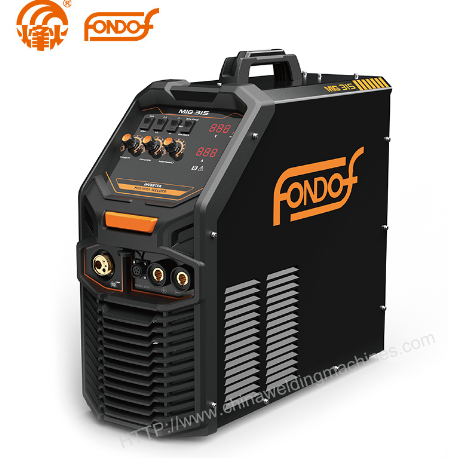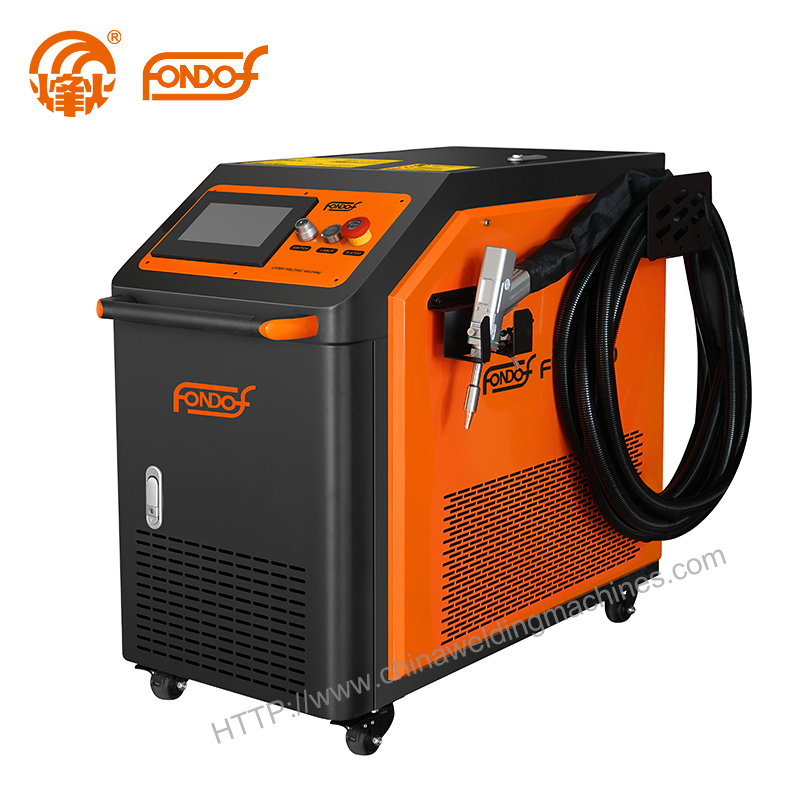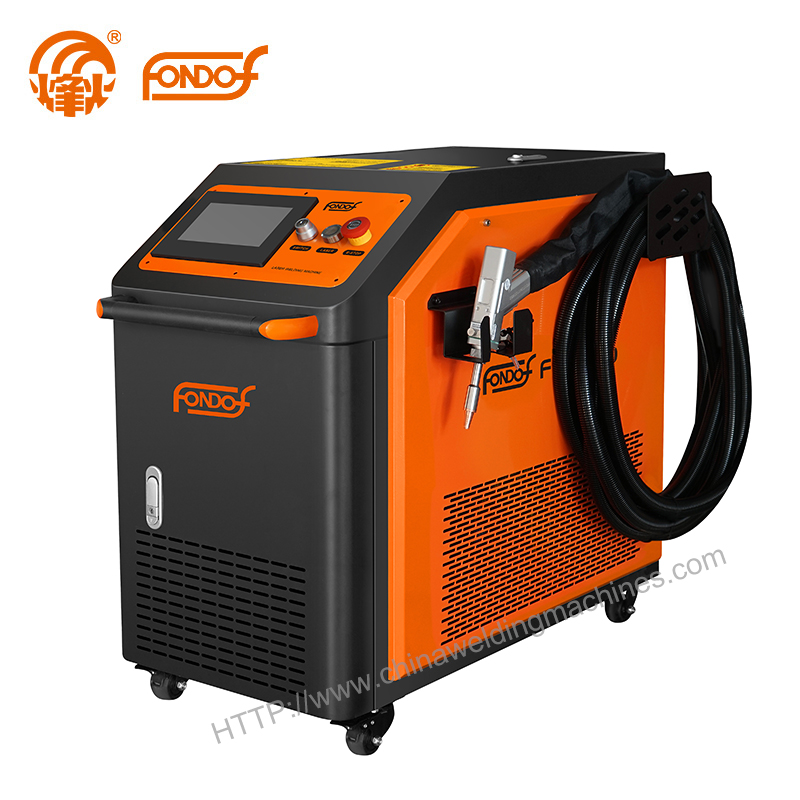Differences between MIG and MMA Welding Machines
 Mar. 22, 2024
Mar. 22, 2024
MIG and MMA welding machines are frequently employed in metal fabrication and welding tasks, yet they exhibit notable distinctions in their operation, ideal welding applications, and compatible materials. This article will delineate the primary disparities between MIG and MMA welding machines.
MIG Welding Machine
MIG, an acronym for Metal Inert Gas welding, utilizes a wire feed system where a continuous wire is fed through a welding gun. Connected to a power source, this wire receives the required electricity to heat and melt, facilitating the fusion of two metal pieces.
MIG welding machines commonly employ a shielding gas to safeguard the weld pool against atmospheric impurities. This gas blend typically comprises argon and carbon dioxide, although alternatives like helium or nitrogen are also viable. The shielding gas is typically delivered through the welding gun alongside the wire.
MIG welding finds frequent application in joining thin sheet metal or other lightweight materials due to its ability to yield clean, precise welds with minimal spatter. It's also suitable for thicker materials like structural steel or aluminum, although adjusting the amperage setting or using a different wire type may be necessary.
MIG welding is favored for its simplicity and efficiency. It's a straightforward technique that can be grasped swiftly, and the uninterrupted wire feed enables rapid welding without frequent pauses for reloading. Nonetheless, MIG welding demands steady hands and precise control, as weld quality can suffer if the operator isn't meticulous.
MMA Welding Machine
MMA stands for Manual Metal Arc welding, a process wherein an electrode, usually a metal rod or stick, is manually introduced into the welding arc. This electrode is linked to a power source that supplies the required electricity to heat and melt the metal, facilitating the fusion of two metal pieces.
MMA welding machines operate without the need for shielding gas, as the electrode possesses a protective coating that melts and envelops the weld pool. This coating serves to shield the weld from atmospheric impurities, thereby preserving weld quality.
MMA welding finds frequent application in joining thicker materials like steel or cast iron, delivering robust and enduring welds capable of withstanding substantial stress and strain. Moreover, it is suitable for outdoor or windy conditions, as the electrode coating offers some resistance against wind and adverse weather conditions.
Mastering MMA welding poses greater challenges compared to MIG welding, demanding precise control over the welding arc and a steady hand. Operators must meticulously manage the electrode angle and uphold a consistent distance between the electrode and the workpiece.
Comparison of MIG and MMA Welding Machines
Operation:
MIG welding machines utilize a continuous wire feed through a welding gun, whereas MMA welding machines employ a manually fed metal electrode into the welding arc.
Shielding gas:
MIG welding machines necessitate a shielding gas to safeguard the weld pool from atmospheric contamination, while MMA welding machines operate without requiring a shielding gas.
Types of welding:
MIG welding is commonly employed for welding thin sheet metal or lightweight materials, whereas MMA welding is preferred for welding thicker materials like steel or cast iron.
Materials:
MIG welding is versatile, suitable for welding various materials including steel, aluminum, and other metals. MMA welding is primarily recommended for welding steel and cast iron.
Ease of use:
MIG welding is generally easier to learn and faster to operate than MMA welding, although it does require a steady hand and good control. MMA welding is more difficult to master but can produce stronger, more durable welds.
It is our great honor to satisfy your requirements on welding products. Any requirement from you will be maximized by us.
Technical Differences
In the field of welding, the technical distinctions between MIG/MAG and MMA welding are essential considerations. These differences significantly impact not only the selection of the appropriate method but also influence factors such as efficiency, weld quality, and suitability for specific applications.
Equipment Requirements: MIG/MAG vs. MMA Welding
MIG/MAG welding systems are generally more complex and consist of several key components: a welding gun, wire feed mechanism, power source, and a shielding gas supply. The welding gun simultaneously delivers the wire electrode, shielding gas, and electric current to the weld zone. Conversely, MMA welding setups are far more straightforward, requiring only a power source and an electrode holder. This simplicity makes MMA welding highly portable and well-suited for use in remote locations or confined spaces. The additional components in MIG/MAG systems—such as gas regulators and cooling units—make them more costly and less mobile. For example, a high-end MIG welder may cost over $1,000, while a basic MMA welder can be found for as little as $100–$200.
Consumables and Materials
The consumables used in MIG/MAG and MMA welding differ considerably. MIG/MAG welding relies on a continuous solid wire electrode available in various diameters and compositions, depending on the base material. Shielding gases, commonly argon or carbon dioxide, are essential to protect the molten weld pool from oxidation and contamination. MMA welding, in contrast, uses flux-coated consumable electrodes. The flux not only shields the arc from atmospheric interference but also contributes alloying elements and stabilizers to enhance weld properties. These electrodes come in various formulations designed to suit different materials and welding conditions.
Welding Process and Technique
The mechanics of each welding method also vary. MIG/MAG welding feeds a continuous wire electrode through the gun, maintaining a consistent arc that melts the wire into the joint. This process is relatively easy to learn, enabling longer, continuous welds that are ideal for high-speed, precision-oriented applications. MMA welding, however, requires manual control of the arc length as the electrode gradually melts. This makes it more skill-intensive and typically slower, but offers enhanced control—particularly useful for welding in vertical, overhead, or hard-to-reach positions.
Each technique has its strengths and limitations. MIG/MAG welding is highly efficient and excels in controlled indoor environments, especially when working with thin materials. However, its reliance on shielding gas makes it less effective in windy or outdoor conditions. MMA welding, on the other hand, is highly adaptable to outdoor environments and thicker materials, making it a preferred method in construction, repair, and heavy-duty applications.
Applications and Suitability
In the welding industry, selecting the appropriate welding process based on specific applications and material requirements is essential for ensuring optimal performance and productivity. Among the widely used methods, MIG/MAG and MMA welding each offer unique advantages tailored to different operational scenarios.
Common Applications of MIG/MAG Welding
MIG/MAG welding is particularly well-suited for applications where precision, speed, and high efficiency are critical. In the automotive manufacturing sector, this technique plays a pivotal role, thanks to its impressive welding speed—capable of reaching up to 120 inches per minute—which significantly boosts production throughput. Additionally, MIG/MAG welding is extensively employed in the fabrication of metal furniture and robotic structures, valued for its ability to deliver clean, high-quality welds with minimal spatter. In the construction industry, especially in the assembly of frameworks and bridges, its compatibility with a range of metals—including aluminum (with thicknesses from 0.5mm to 4mm), stainless steel, and carbon steel—makes it a highly versatile solution.
Common Applications of MMA Welding
MMA welding, on the other hand, demonstrates exceptional performance in outdoor environments and locations with restricted access to stable power sources. It is a preferred choice for pipeline welding, where pipe wall thickness typically ranges from 3.2mm to over 10mm, requiring a robust and adaptable technique. This method is also indispensable in shipbuilding and heavy steel construction, where the ability to handle thick materials and challenging conditions is crucial. One of the standout benefits of MMA welding is its resistance to wind and harsh weather, which can easily disrupt the shielding gas used in MIG/MAG welding. This resilience makes MMA welding the ideal option for outdoor and remote site projects.
Advantages of MIG/MAG Welding Over MMA
MIG/MAG welding presents several clear advantages when compared to MMA welding:
Higher Speed and Productivity: MIG/MAG welding operates at significantly higher speeds, enabling greater weld deposition rates per hour. This makes it particularly valuable in industrial settings where production efficiency is a top priority.
Superior Control on Thin Materials: It offers enhanced control when working with thinner metals, minimizing the risk of distortion or burn-through, which can be a challenge with MMA welding.
Cleaner, Low-Spatter Welds: MIG/MAG welding produces cleaner welds with minimal spatter, reducing the amount of post-weld cleaning and finishing required.
Ease of Operation: Generally easier to learn and operate, MIG/MAG welding is well-suited for beginners and operators with limited experience, shortening the learning curve.
Broad Material Compatibility: This process can be effectively applied to a wide range of metals and alloys, increasing its versatility across various industries.
Limitations of MIG/MAG Compared to MMA
Despite its advantages, MIG/MAG welding comes with certain limitations:
Higher Equipment Costs: The initial investment for MIG/MAG welding equipment is notably higher due to the additional components such as gas cylinders, wire feeders, and specialized power sources.
Reduced Portability: MIG/MAG systems are less mobile than the compact and lightweight MMA setups, making them less convenient for fieldwork or remote job sites.
Environmental Sensitivity: MIG/MAG welding’s reliance on shielding gas makes it vulnerable to wind and adverse outdoor conditions, which can compromise weld quality by dispersing the protective gas shield.
Cost and Efficiency Considerations
Several factors influence the overall cost and operational efficiency of these two welding methods:
Initial Investment: MIG/MAG welding systems typically require a higher upfront cost, often amounting to several thousand dollars for a complete setup, while a functional MMA welding kit can be assembled for a few hundred dollars.
Operating Expenses: MIG/MAG welding involves ongoing costs for shielding gas and consumable wire electrodes, whereas MMA welding primarily incurs expenses for replacement electrodes.
Labor Efficiency: Thanks to its faster deposition rates and ease of operation, MIG/MAG welding can significantly reduce labor time and costs, especially beneficial in large-scale production or long-duration projects.
In summary, MIG/MAG welding excels in speed, efficiency, and ease of operation, though it demands a higher investment and is less adaptable to outdoor or variable environments. MMA welding, on the other hand, remains a practical, cost-effective option for heavy-duty or field-based applications. The ideal choice ultimately depends on project-specific factors such as material type, job scale, budget, and working conditions.
A thorough understanding of the technical differences between MIG/MAG and MMA welding is critical for professionals in selecting the most suitable method for their specific tasks. These differences also influence the training pathways for welders, as each technique demands a distinct set of skills, experience, and operational knowledge.
 Previous:
What is MIG/MAG Welding?
Previous:
What is MIG/MAG Welding?




























